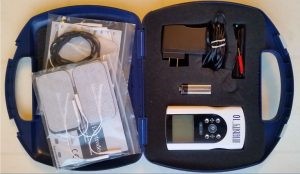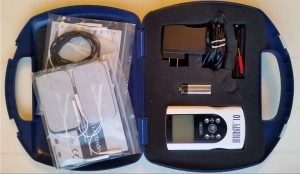This is a b-a-d play on words, even for me! I just ordered a Transcutaneous Electrical Nerve Stimulation (TENS) therapeutic device, and realized that it’s June 10th –> So that makes it a TENS on the 10th!
The unit I ordered is a portable electrotherapy device, used (hopefully!) for pain relief. This is the latest suggestion from my physiotherapist, who has really taken a proactive role in helping me try to deal with CRPS/RSD. It’s a rare & very painful neuro-inflammatory disease; I was diagnosed in late May, although it began in March. You can read about my diagnosis here.
The principle of nerve stimulation is to use electrodes, placed at specific places on the skin, to transmit a mild electrical current to the nerves (and muscles). The intensity of the current can be adjusted to suit the individual patient, as well as the condition being treated.
A TENS unit consists of an electronic stimulus generator and electrodes which are placed directly on the skin. It has been reported that this technology is effective in controlling pain in a number of applications and thus has been adopted by many health professionals.
In Canada, TENS is usually provided by physiotherapists, in hospitals and clinics. No major adverse effects have been reported with the use of TENS”(1).
If you read my blog, you know that I work in bioethics (medical ethics); so I look at the benefit versus the risk of any potential treatment. TENS is a drug-free pain option, and is non-invasive (doesn’t break the skin, unlike an injection), so it’s a fairly low-risk treatment. It’s also relatively inexpensive; I found one on-sale at Costco (Canada) for $50. For the sake of comparison, my 3-times a week 1-hour physiotherapy sessions are $85 each.

So, how could a TENS possibly alleviate pain? It helps to consider what pain is, before trying to understand how TENS can help with it! My best attempt at explaining the underlying concept of pain is that it’s like a message to and from the brain. Think of it kind of like an email message; I’m going to call it pain-mail, no, wait – Pmail!
The body’s initial Pmail message is created at the injured area of the body, and then coded (kind of like email encryption!) and sent along the small nerves to the spinal cord. The spinal cord acts something like a switch (or a router), and passes the Pmail along to different nerves that travel up the spinal cord to the brain.
The brain (think of it like an email server) interprets the Pmail (similar to decryption, or unscrambling a coded message), and then sends a decoded pain message back to the site of the injury.
It’s this uncoded Pmail that causes the sensation of pain to be felt. In chronic pain diseases – with both long-lasting & persistent pain – these pathways seem to become altered. The brain keeps sending pain messages, even after the initial injury has healed.
This isn’t the best explanation of pain, but it’s mine – after a lot of reading & personal research into this topic over the past few months!
Okay, so now we have a quick understanding of why, or how, we feel pain. That still doesn’t explain what a TENS is supposed to do about pain…
The idea is that the nerve stimulation will reduce the perception of pain; for some patients & conditions this reduction in pain sensations will only last as long as the treatment, and for others it may last longer.
The longest duration of pain relief I’ve seen, for portable TENS machines, is about 4 times as long as the treatment; so a 15-minute treatment could provide relief for an hour.
Those mild electrical currents don’t treat any injury or physical condition; their goal is simply to help control the pain. And, like most of the tools or treatments I’ve tried for CRPS, it comes with a warning that it may not work for everyone or for every condition.
So it’s the same situation as for just about everything about this rare disease; it’s another “let’s try it and see if it helps” situation.
TENS isn’t meant to be a permanent approach to pain, but rather another tool to help try to ‘live with’ chronic and extreme pain. Even so, I’m very curious to see whether it will make any difference for Complex Regional Pain Syndrome (CRPS) – often still called by its old name of Reflex Sympathetic Dystrophy (RSD).
My purchase should be delivered within a week; stay tuned for an update after I’ve used it for a few weeks.
References:
(1) Reeve J, Corabian P. Transcutaneous Electrical Nerve
Stimulation (Tens) and Pain Management. Ottawa: Canadian Coordinating Office
for Health Technology Assessment (CCOHTA). Health Technology Assessment. 01 Apr
1995. Online. Accessed 10 Jun 2016. Web:
https://www.cadth.ca/transcutaneous-electrical-nerve-stimulation-tens-and-pain-management-0

